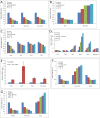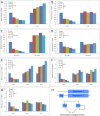Network features of the mammalian circadian clock
- PMID: 19278294
- PMCID: PMC2653556
- DOI: 10.1371/journal.pbio.1000052
Network features of the mammalian circadian clock
Abstract
The mammalian circadian clock is a cell-autonomous system that drives oscillations in behavior and physiology in anticipation of daily environmental change. To assess the robustness of a human molecular clock, we systematically depleted known clock components and observed that circadian oscillations are maintained over a wide range of disruptions. We developed a novel strategy termed Gene Dosage Network Analysis (GDNA) in which small interfering RNA (siRNA)-induced dose-dependent changes in gene expression were used to build gene association networks consistent with known biochemical constraints. The use of multiple doses powered the analysis to uncover several novel network features of the circadian clock, including proportional responses and signal propagation through interacting genetic modules. We also observed several examples where a gene is up-regulated following knockdown of its paralog, suggesting the clock network utilizes active compensatory mechanisms rather than simple redundancy to confer robustness and maintain function. We propose that these network features act in concert as a genetic buffering system to maintain clock function in the face of genetic and environmental perturbation.
Conflict of interest statement
Competing interests. The authors have declared that no competing interests exist.
Figures





References
-
- Stratmann M, Schibler U. Properties, entrainment, and physiological functions of mammalian peripheral oscillators. J Biol Rhythms. 2006;21:494–506. - PubMed
-
- Ko CH, Takahashi JS. Molecular components of the mammalian circadian clock. Hum Mol Genet. 2006;15(Spec No 2):R271–277. - PubMed
-
- Reppert SM, Weaver DR. Coordination of circadian timing in mammals. Nature. 2002;418:935–941. - PubMed
-
- Waddington CH. Canalization of development and the inheritance of acquired characters. Nature. 1942;150:563–565. - PubMed
-
- Gallego M, Virshup DM. Post-translational modifications regulate the ticking of the circadian clock. Nat Rev Mol Cell Biol. 2007;8:139–148. - PubMed
Publication types
MeSH terms
Substances
Grants and funding
LinkOut - more resources
Full Text Sources
Other Literature Sources
Molecular Biology Databases

